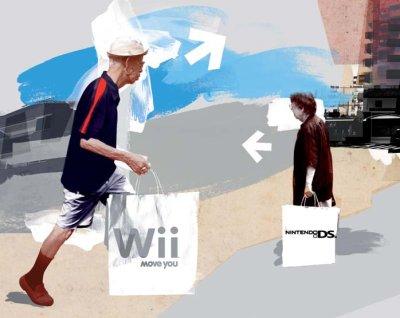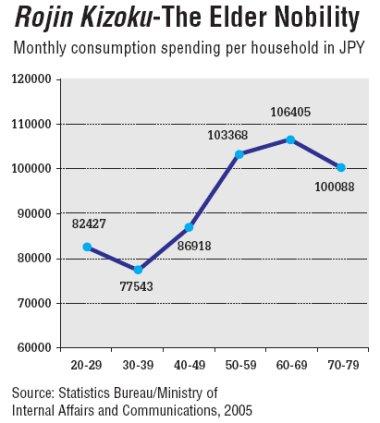The Silver Market Phenomenon
The aging and shrinking society has huge implications for businesses in Japan
By Dr Florian Kohlbacher and Dr Cornelius Herstatt
 Illustration: Phillip Couzens (www.freesouldesign.co.uk)
Illustration: Phillip Couzens (www.freesouldesign.co.uk)
The current shift in demographics around the world, with increasingly aging and shrinking populations, presents a major challenge to companies and societies alike.
Most accounts of the so-called demographic “problem” deal with the threats posed by declining numbers in terms of the shrinking workforce, the added welfare burden, social conflict and so on. Chances and opportunities are often neglected. The emergence of new markets, the potential for innovation, the integration of older people into jobs and workplaces, the joy of active aging and varied roles within the society are just a few examples of what at first appears to be a crisis, but what could also be a valuable opportunity.
From silver to gold
One particularly essential implication of the demographic shift is the emergence and constant growth of the so-called “greying market” or “silver market,” the market segment more or less broadly defined as those aged between 50-55 and older. Increasing in number and in their share of the total population, while at the same time being relatively well-off, this group of consumers can be seen as very attractive and promising, although still very underdeveloped in terms of product and service offerings. Note that this is both true for the B2C as well as the B2B sectors as the workforce of organizations is also aging. This means that workplaces also need to be adapted to fit the needs of an aging workforce.
 The new HAL suit Robotic assistance for the elderly
The new HAL suit Robotic assistance for the elderly
Japan is the country most severely affected by the demographic shift and it is the most advanced in terms of product development and innovation with very affluent, free-spending but also demanding customers. Japanese companies were among the first to react to the challenge of the demographic change and are constantly coming up with product as well as service innovations. Nevertheless, they have only touched the tip of the iceberg in terms of the huge market potential. Overall, Japan can be seen as the leading silver market, which offers the opportunity to study the silver market phenomenon and learn from the successes and failures of Japanese pioneer firms. Examples include NTT Docomo’s ‘Raku-Raku’ (Easy- Easy) phone, with its strong emphasis on usability including easy-to-read fonts, keys and functions. Many innovations can be found in the area of supportive devices, such as the Robot Suit HAL (Hybrid Assistive Limb). Developed by University of Tsukuba Professor Sankai, it helps handicapped and elderly people to move their limbs as well as workers to carry heavy weights by wearing a cyborg- type robotic suit. And last but not least, the Japanese automotive industry is also busy developing cars for the elderly, placing an emphasis on safety and accessibility.
Beware of ageism, think transgenerationally!
Despite what you may read in the popular press and in “marketing to baby boomers” books, the silver market is by no means a homogenous market We should resist the temptation of getting too carried away by people’s agesegment and the over-50 market covers a wide range of different customers and consumers with an equally diverse range of values, attitudes, needs and wants. Thus, the silver market consists of various different sub-markets. In a similar vein, we should not forget that marketing has for a long time already gone beyond the simplistic segmentation by age and that despite the tremendous business potential of the over-50s, we should resist the temptation of getting too carried away by people’s age.
Another aspect to consider is that the silver market is not necessarily restricted to the silver generation only and it is important to remember the powerful concepts of universal and ‘transgenerational’ design. The best products, services and solutions are often those that can be attractive to a variety of customers regardless of their age, physical condition or mental wellbeing. In other words, beware of ageism, think transgenerationally! One of the most prominent and successful examples of this is Nintendo’s game console ‘Wii’ and the handheld computer game ‘DS.’  The best feature of the Wii is the innovative controller which can detect and transmit the movements of the players directly into virtual reality, leading to an absolutely new experience of video game playing. It has successfully disrupted the market, giving Nintendo a substantial lead over Sony and Microsoft who are still focusing on graphics and performance. The Wii has helped Nintendo tap into new customer segments, fighting against the so far largely non-responsive market sector of women and elderly people. A truly transgenerational product that enables the whole family and people of all ages to enjoy the game together, it’s easy to see why both Wii and DS are marketed with the slogan “Touch Generations.”
The best feature of the Wii is the innovative controller which can detect and transmit the movements of the players directly into virtual reality, leading to an absolutely new experience of video game playing. It has successfully disrupted the market, giving Nintendo a substantial lead over Sony and Microsoft who are still focusing on graphics and performance. The Wii has helped Nintendo tap into new customer segments, fighting against the so far largely non-responsive market sector of women and elderly people. A truly transgenerational product that enables the whole family and people of all ages to enjoy the game together, it’s easy to see why both Wii and DS are marketed with the slogan “Touch Generations.”
Opportunity for Innovation
Finally, the opportunities ahead will not be less than the challenges. The baby boomers (dankai no sedai) will continue to age and retire and so will their children in the future. The ‘Silver Market Phenomenon’ will not only be an opportunity for business but also an opportunity for innovation and invention, creativity, learning and social response and responsibility. Japan could certainly serve as an interesting role model for the rest of the world. JI
THE AUTHORS:
Dr Florian Kohlbacher is a research fellow at the German Institute for Japanese Studies in Tokyo. He teaches business and management at several universities in Tokyo. Prof Dr Cornelius Herstatt is Managing Director and full professor of the Institute for Technology and Innovation Management (TIM), Hamburg University of Technology (TUHH), Germany.
Florian Kohlbacher and Cornelius Herstatt are also the co-editors of “The Silver Market Phenomenon: Business Opportunities in an Era of Demographic Change,” published by Springer in September 2008. They will be holding a symposium called “The Silver Market Phenomenom: Business Opportunities and Responsibilities in the Aging Society” on October 3 and 4 at the United Nations University headquarters in Tokyo.





